Corporate Governance, Ethics, and CSR Report: SDG First Goal Analysis
VerifiedAdded on 2023/06/05
|14
|4079
|361
Report
AI Summary
This report focuses on the first Sustainable Development Goal (SDG), which is to eradicate poverty, and analyzes the efforts of the United Nations in achieving this goal. It begins with an introduction to the global poverty issue and the UN's approach, highlighting the importance of the first SDG. The report then delves into UN corporate governance, exploring its structure, including executive and non-executive directors, and the role of sub-committees. A stakeholder map is presented, identifying various stakeholders such as farmers, children, governments, and NGOs, and describing their relationships with the goal of poverty reduction. The report further discusses the Principles for Responsible Management Education (PRME) and how these principles contribute to poverty eradication, including its purpose, values, method, research, partnership, and dialogue. Finally, the report concludes with recommendations based on PRME principles, aimed at improving poverty reduction strategies.
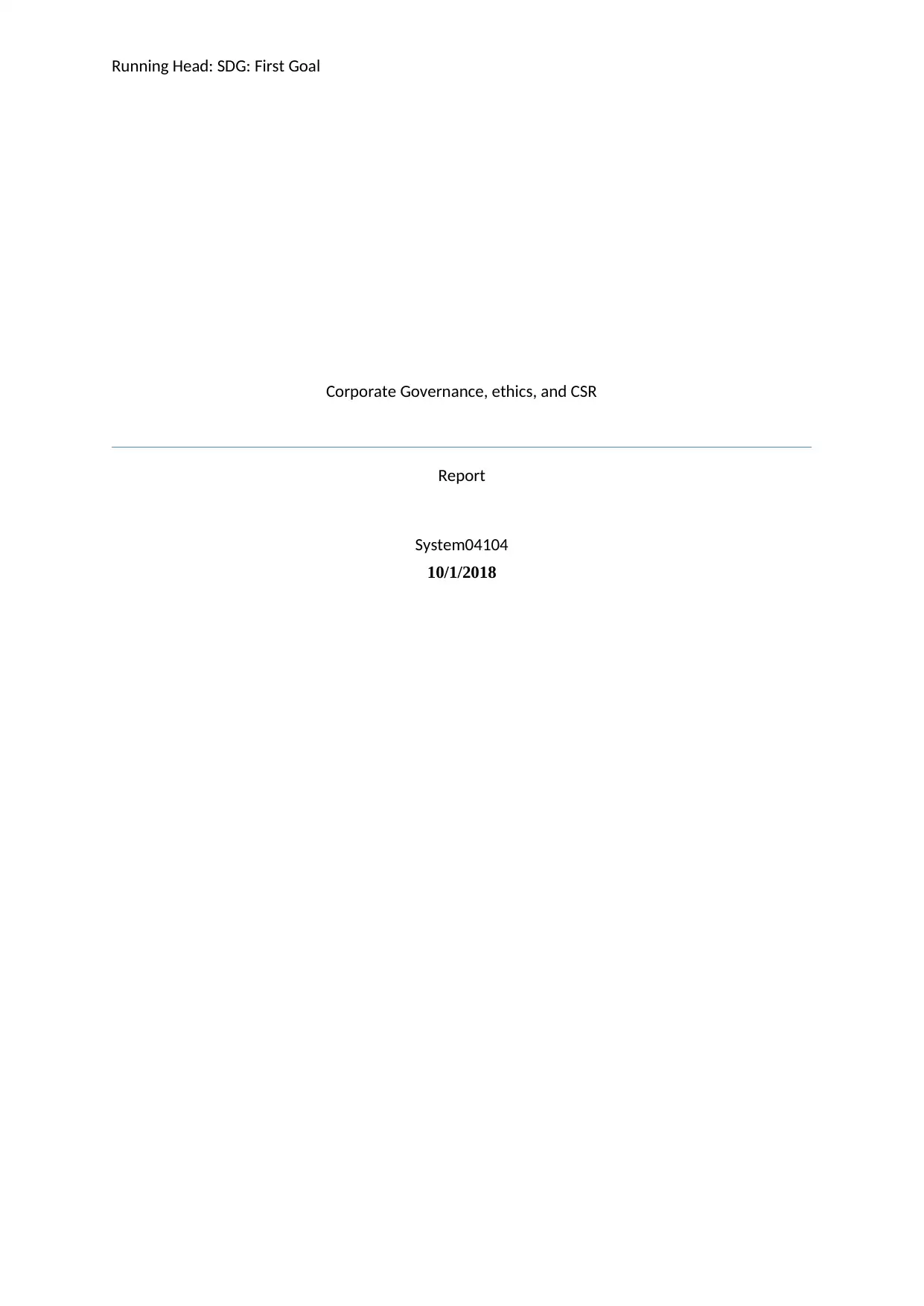
Running Head: SDG: First Goal
Corporate Governance, ethics, and CSR
Report
System04104
10/1/2018
Corporate Governance, ethics, and CSR
Report
System04104
10/1/2018
Paraphrase This Document
Need a fresh take? Get an instant paraphrase of this document with our AI Paraphraser
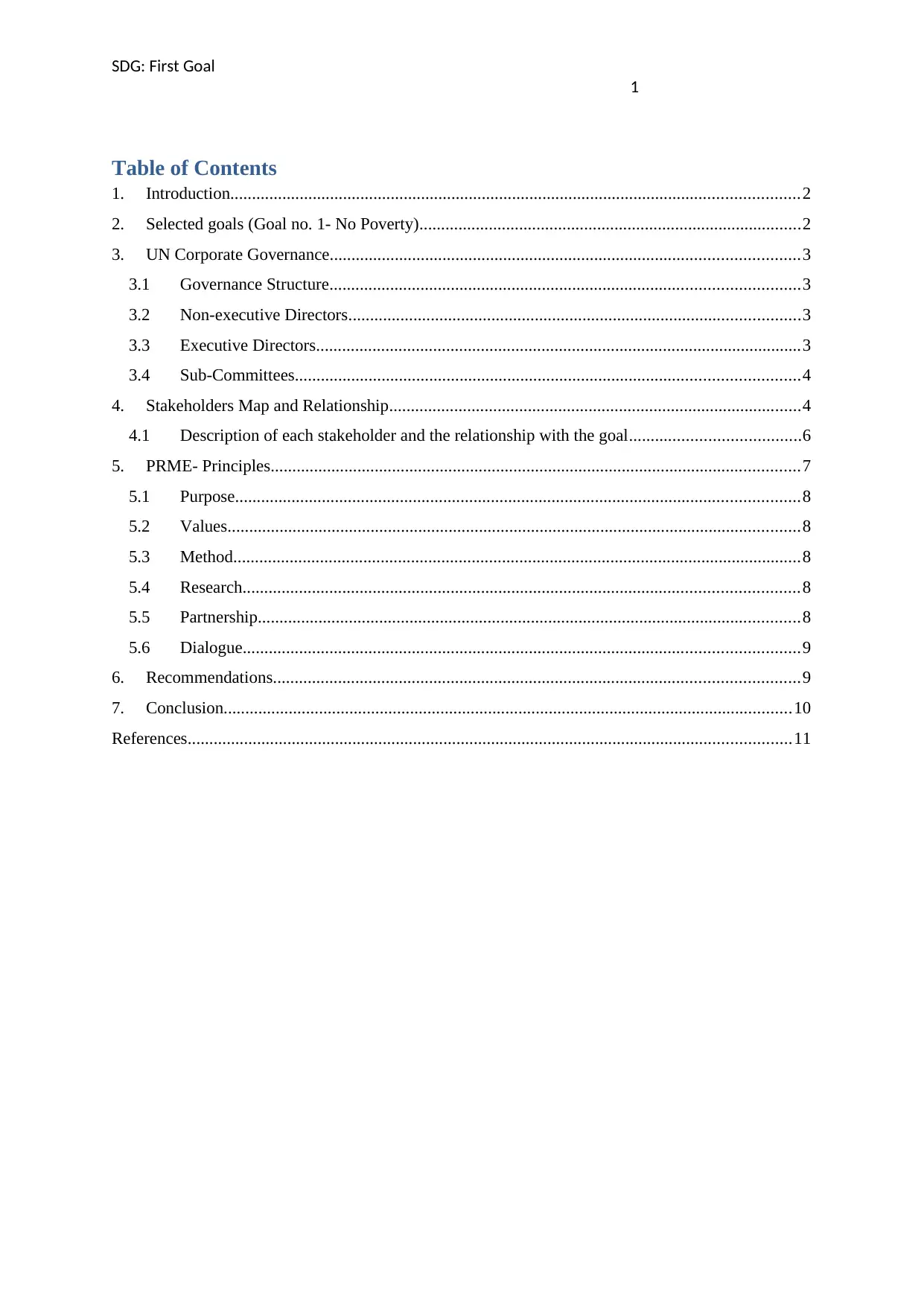
SDG: First Goal
1
Table of Contents
1. Introduction...................................................................................................................................2
2. Selected goals (Goal no. 1- No Poverty)........................................................................................2
3. UN Corporate Governance............................................................................................................3
3.1 Governance Structure............................................................................................................3
3.2 Non-executive Directors........................................................................................................3
3.3 Executive Directors................................................................................................................3
3.4 Sub-Committees....................................................................................................................4
4. Stakeholders Map and Relationship...............................................................................................4
4.1 Description of each stakeholder and the relationship with the goal.......................................6
5. PRME- Principles..........................................................................................................................7
5.1 Purpose..................................................................................................................................8
5.2 Values....................................................................................................................................8
5.3 Method...................................................................................................................................8
5.4 Research................................................................................................................................8
5.5 Partnership.............................................................................................................................8
5.6 Dialogue................................................................................................................................9
6. Recommendations.........................................................................................................................9
7. Conclusion...................................................................................................................................10
References...........................................................................................................................................11
1
Table of Contents
1. Introduction...................................................................................................................................2
2. Selected goals (Goal no. 1- No Poverty)........................................................................................2
3. UN Corporate Governance............................................................................................................3
3.1 Governance Structure............................................................................................................3
3.2 Non-executive Directors........................................................................................................3
3.3 Executive Directors................................................................................................................3
3.4 Sub-Committees....................................................................................................................4
4. Stakeholders Map and Relationship...............................................................................................4
4.1 Description of each stakeholder and the relationship with the goal.......................................6
5. PRME- Principles..........................................................................................................................7
5.1 Purpose..................................................................................................................................8
5.2 Values....................................................................................................................................8
5.3 Method...................................................................................................................................8
5.4 Research................................................................................................................................8
5.5 Partnership.............................................................................................................................8
5.6 Dialogue................................................................................................................................9
6. Recommendations.........................................................................................................................9
7. Conclusion...................................................................................................................................10
References...........................................................................................................................................11
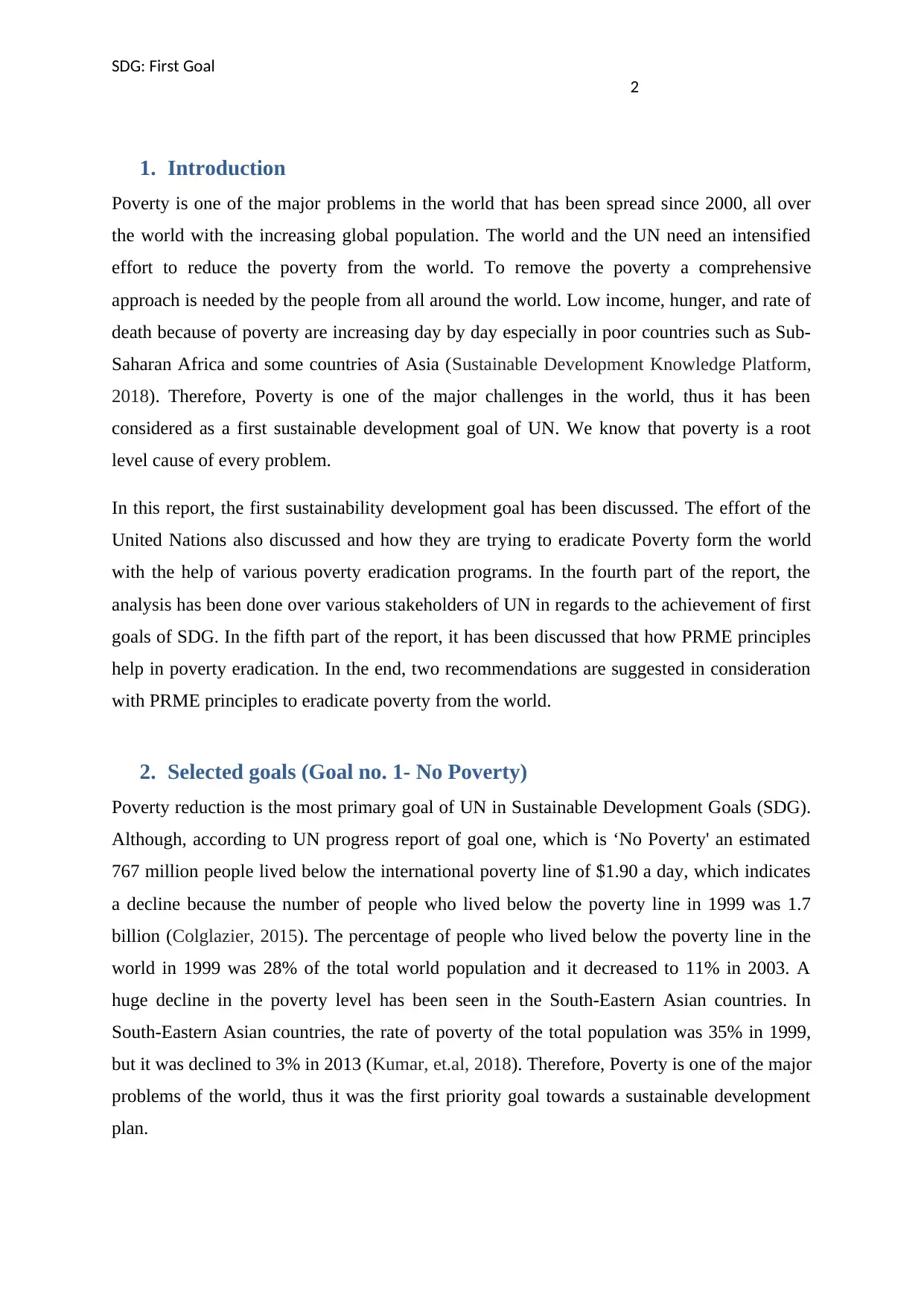
SDG: First Goal
2
1. Introduction
Poverty is one of the major problems in the world that has been spread since 2000, all over
the world with the increasing global population. The world and the UN need an intensified
effort to reduce the poverty from the world. To remove the poverty a comprehensive
approach is needed by the people from all around the world. Low income, hunger, and rate of
death because of poverty are increasing day by day especially in poor countries such as Sub-
Saharan Africa and some countries of Asia (Sustainable Development Knowledge Platform,
2018). Therefore, Poverty is one of the major challenges in the world, thus it has been
considered as a first sustainable development goal of UN. We know that poverty is a root
level cause of every problem.
In this report, the first sustainability development goal has been discussed. The effort of the
United Nations also discussed and how they are trying to eradicate Poverty form the world
with the help of various poverty eradication programs. In the fourth part of the report, the
analysis has been done over various stakeholders of UN in regards to the achievement of first
goals of SDG. In the fifth part of the report, it has been discussed that how PRME principles
help in poverty eradication. In the end, two recommendations are suggested in consideration
with PRME principles to eradicate poverty from the world.
2. Selected goals (Goal no. 1- No Poverty)
Poverty reduction is the most primary goal of UN in Sustainable Development Goals (SDG).
Although, according to UN progress report of goal one, which is ‘No Poverty' an estimated
767 million people lived below the international poverty line of $1.90 a day, which indicates
a decline because the number of people who lived below the poverty line in 1999 was 1.7
billion (Colglazier, 2015). The percentage of people who lived below the poverty line in the
world in 1999 was 28% of the total world population and it decreased to 11% in 2003. A
huge decline in the poverty level has been seen in the South-Eastern Asian countries. In
South-Eastern Asian countries, the rate of poverty of the total population was 35% in 1999,
but it was declined to 3% in 2013 (Kumar, et.al, 2018). Therefore, Poverty is one of the major
problems of the world, thus it was the first priority goal towards a sustainable development
plan.
2
1. Introduction
Poverty is one of the major problems in the world that has been spread since 2000, all over
the world with the increasing global population. The world and the UN need an intensified
effort to reduce the poverty from the world. To remove the poverty a comprehensive
approach is needed by the people from all around the world. Low income, hunger, and rate of
death because of poverty are increasing day by day especially in poor countries such as Sub-
Saharan Africa and some countries of Asia (Sustainable Development Knowledge Platform,
2018). Therefore, Poverty is one of the major challenges in the world, thus it has been
considered as a first sustainable development goal of UN. We know that poverty is a root
level cause of every problem.
In this report, the first sustainability development goal has been discussed. The effort of the
United Nations also discussed and how they are trying to eradicate Poverty form the world
with the help of various poverty eradication programs. In the fourth part of the report, the
analysis has been done over various stakeholders of UN in regards to the achievement of first
goals of SDG. In the fifth part of the report, it has been discussed that how PRME principles
help in poverty eradication. In the end, two recommendations are suggested in consideration
with PRME principles to eradicate poverty from the world.
2. Selected goals (Goal no. 1- No Poverty)
Poverty reduction is the most primary goal of UN in Sustainable Development Goals (SDG).
Although, according to UN progress report of goal one, which is ‘No Poverty' an estimated
767 million people lived below the international poverty line of $1.90 a day, which indicates
a decline because the number of people who lived below the poverty line in 1999 was 1.7
billion (Colglazier, 2015). The percentage of people who lived below the poverty line in the
world in 1999 was 28% of the total world population and it decreased to 11% in 2003. A
huge decline in the poverty level has been seen in the South-Eastern Asian countries. In
South-Eastern Asian countries, the rate of poverty of the total population was 35% in 1999,
but it was declined to 3% in 2013 (Kumar, et.al, 2018). Therefore, Poverty is one of the major
problems of the world, thus it was the first priority goal towards a sustainable development
plan.
⊘ This is a preview!⊘
Do you want full access?
Subscribe today to unlock all pages.

Trusted by 1+ million students worldwide
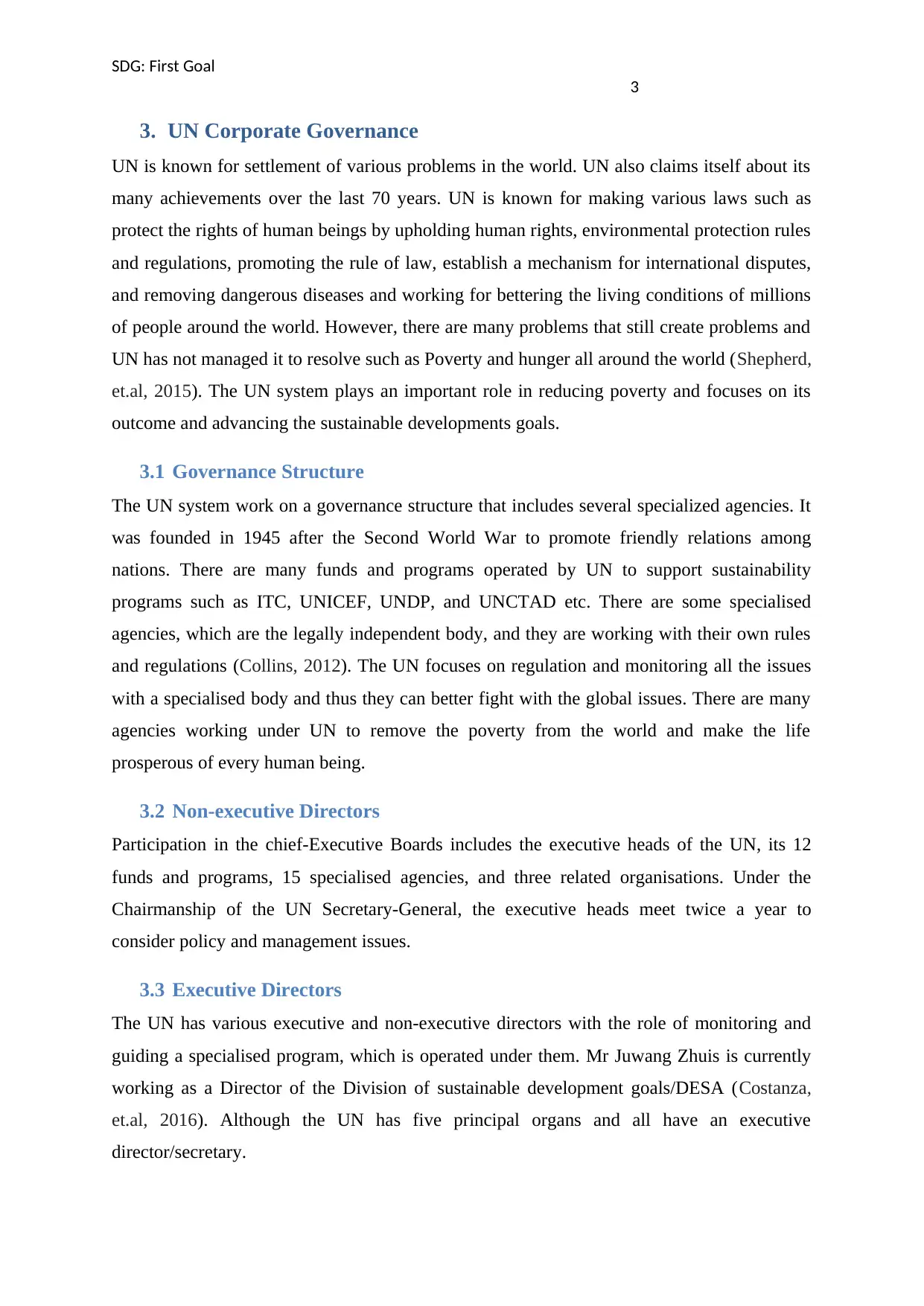
SDG: First Goal
3
3. UN Corporate Governance
UN is known for settlement of various problems in the world. UN also claims itself about its
many achievements over the last 70 years. UN is known for making various laws such as
protect the rights of human beings by upholding human rights, environmental protection rules
and regulations, promoting the rule of law, establish a mechanism for international disputes,
and removing dangerous diseases and working for bettering the living conditions of millions
of people around the world. However, there are many problems that still create problems and
UN has not managed it to resolve such as Poverty and hunger all around the world (Shepherd,
et.al, 2015). The UN system plays an important role in reducing poverty and focuses on its
outcome and advancing the sustainable developments goals.
3.1 Governance Structure
The UN system work on a governance structure that includes several specialized agencies. It
was founded in 1945 after the Second World War to promote friendly relations among
nations. There are many funds and programs operated by UN to support sustainability
programs such as ITC, UNICEF, UNDP, and UNCTAD etc. There are some specialised
agencies, which are the legally independent body, and they are working with their own rules
and regulations (Collins, 2012). The UN focuses on regulation and monitoring all the issues
with a specialised body and thus they can better fight with the global issues. There are many
agencies working under UN to remove the poverty from the world and make the life
prosperous of every human being.
3.2 Non-executive Directors
Participation in the chief-Executive Boards includes the executive heads of the UN, its 12
funds and programs, 15 specialised agencies, and three related organisations. Under the
Chairmanship of the UN Secretary-General, the executive heads meet twice a year to
consider policy and management issues.
3.3 Executive Directors
The UN has various executive and non-executive directors with the role of monitoring and
guiding a specialised program, which is operated under them. Mr Juwang Zhuis is currently
working as a Director of the Division of sustainable development goals/DESA (Costanza,
et.al, 2016). Although the UN has five principal organs and all have an executive
director/secretary.
3
3. UN Corporate Governance
UN is known for settlement of various problems in the world. UN also claims itself about its
many achievements over the last 70 years. UN is known for making various laws such as
protect the rights of human beings by upholding human rights, environmental protection rules
and regulations, promoting the rule of law, establish a mechanism for international disputes,
and removing dangerous diseases and working for bettering the living conditions of millions
of people around the world. However, there are many problems that still create problems and
UN has not managed it to resolve such as Poverty and hunger all around the world (Shepherd,
et.al, 2015). The UN system plays an important role in reducing poverty and focuses on its
outcome and advancing the sustainable developments goals.
3.1 Governance Structure
The UN system work on a governance structure that includes several specialized agencies. It
was founded in 1945 after the Second World War to promote friendly relations among
nations. There are many funds and programs operated by UN to support sustainability
programs such as ITC, UNICEF, UNDP, and UNCTAD etc. There are some specialised
agencies, which are the legally independent body, and they are working with their own rules
and regulations (Collins, 2012). The UN focuses on regulation and monitoring all the issues
with a specialised body and thus they can better fight with the global issues. There are many
agencies working under UN to remove the poverty from the world and make the life
prosperous of every human being.
3.2 Non-executive Directors
Participation in the chief-Executive Boards includes the executive heads of the UN, its 12
funds and programs, 15 specialised agencies, and three related organisations. Under the
Chairmanship of the UN Secretary-General, the executive heads meet twice a year to
consider policy and management issues.
3.3 Executive Directors
The UN has various executive and non-executive directors with the role of monitoring and
guiding a specialised program, which is operated under them. Mr Juwang Zhuis is currently
working as a Director of the Division of sustainable development goals/DESA (Costanza,
et.al, 2016). Although the UN has five principal organs and all have an executive
director/secretary.
Paraphrase This Document
Need a fresh take? Get an instant paraphrase of this document with our AI Paraphraser
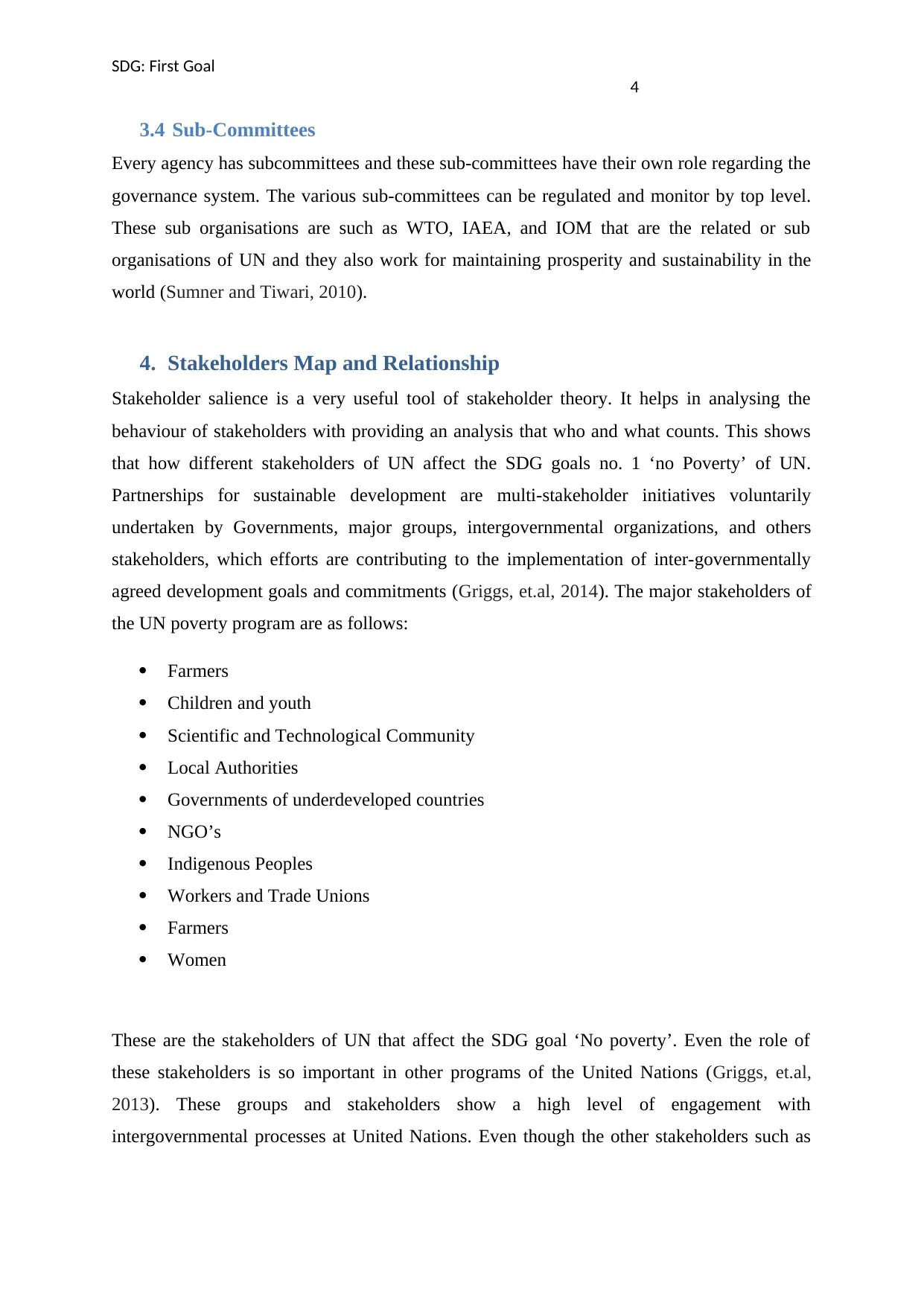
SDG: First Goal
4
3.4 Sub-Committees
Every agency has subcommittees and these sub-committees have their own role regarding the
governance system. The various sub-committees can be regulated and monitor by top level.
These sub organisations are such as WTO, IAEA, and IOM that are the related or sub
organisations of UN and they also work for maintaining prosperity and sustainability in the
world (Sumner and Tiwari, 2010).
4. Stakeholders Map and Relationship
Stakeholder salience is a very useful tool of stakeholder theory. It helps in analysing the
behaviour of stakeholders with providing an analysis that who and what counts. This shows
that how different stakeholders of UN affect the SDG goals no. 1 ‘no Poverty’ of UN.
Partnerships for sustainable development are multi-stakeholder initiatives voluntarily
undertaken by Governments, major groups, intergovernmental organizations, and others
stakeholders, which efforts are contributing to the implementation of inter-governmentally
agreed development goals and commitments (Griggs, et.al, 2014). The major stakeholders of
the UN poverty program are as follows:
Farmers
Children and youth
Scientific and Technological Community
Local Authorities
Governments of underdeveloped countries
NGO’s
Indigenous Peoples
Workers and Trade Unions
Farmers
Women
These are the stakeholders of UN that affect the SDG goal ‘No poverty’. Even the role of
these stakeholders is so important in other programs of the United Nations (Griggs, et.al,
2013). These groups and stakeholders show a high level of engagement with
intergovernmental processes at United Nations. Even though the other stakeholders such as
4
3.4 Sub-Committees
Every agency has subcommittees and these sub-committees have their own role regarding the
governance system. The various sub-committees can be regulated and monitor by top level.
These sub organisations are such as WTO, IAEA, and IOM that are the related or sub
organisations of UN and they also work for maintaining prosperity and sustainability in the
world (Sumner and Tiwari, 2010).
4. Stakeholders Map and Relationship
Stakeholder salience is a very useful tool of stakeholder theory. It helps in analysing the
behaviour of stakeholders with providing an analysis that who and what counts. This shows
that how different stakeholders of UN affect the SDG goals no. 1 ‘no Poverty’ of UN.
Partnerships for sustainable development are multi-stakeholder initiatives voluntarily
undertaken by Governments, major groups, intergovernmental organizations, and others
stakeholders, which efforts are contributing to the implementation of inter-governmentally
agreed development goals and commitments (Griggs, et.al, 2014). The major stakeholders of
the UN poverty program are as follows:
Farmers
Children and youth
Scientific and Technological Community
Local Authorities
Governments of underdeveloped countries
NGO’s
Indigenous Peoples
Workers and Trade Unions
Farmers
Women
These are the stakeholders of UN that affect the SDG goal ‘No poverty’. Even the role of
these stakeholders is so important in other programs of the United Nations (Griggs, et.al,
2013). These groups and stakeholders show a high level of engagement with
intergovernmental processes at United Nations. Even though the other stakeholders such as
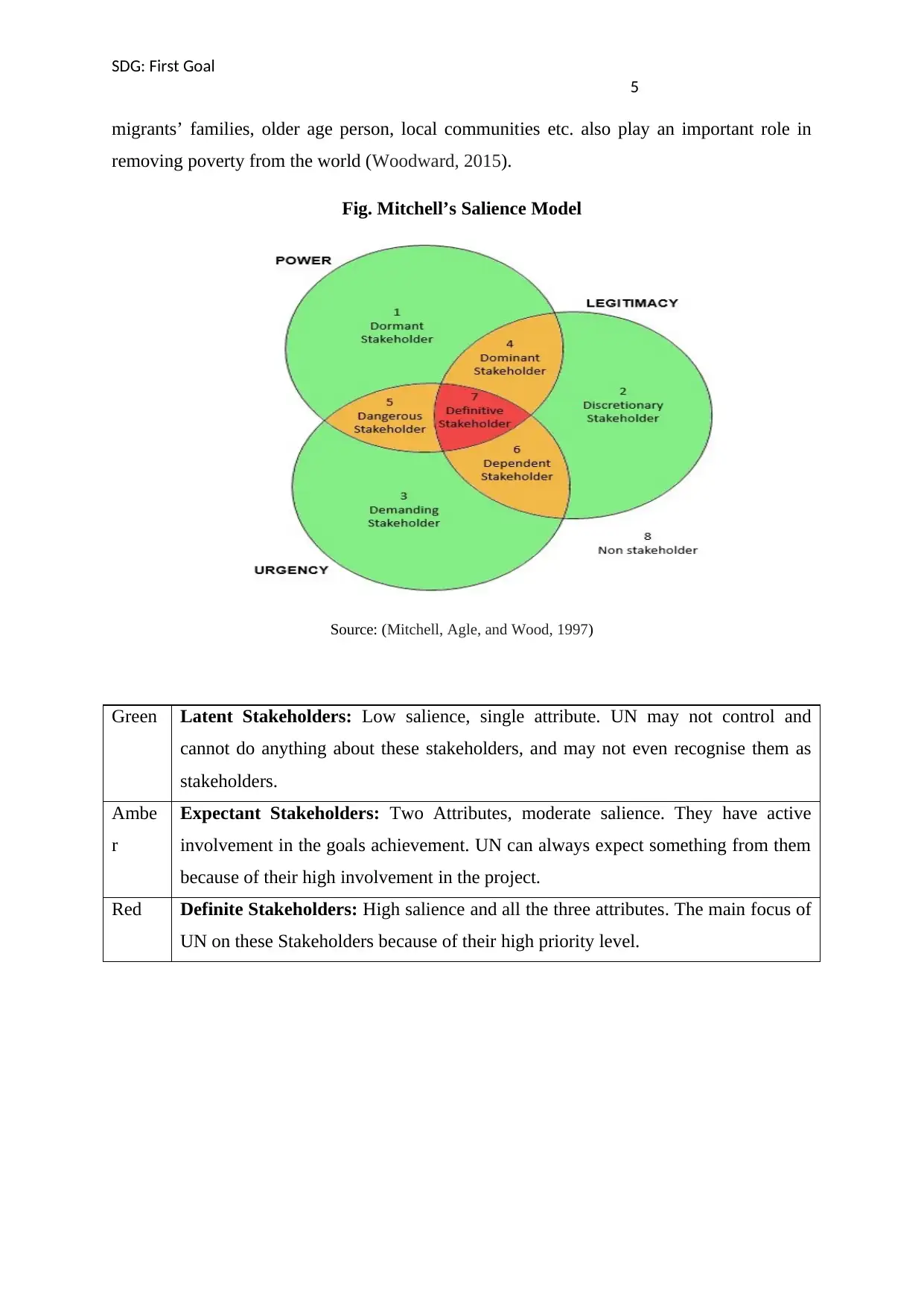
SDG: First Goal
5
migrants’ families, older age person, local communities etc. also play an important role in
removing poverty from the world (Woodward, 2015).
Fig. Mitchell’s Salience Model
Source: (Mitchell, Agle, and Wood, 1997)
Green Latent Stakeholders: Low salience, single attribute. UN may not control and
cannot do anything about these stakeholders, and may not even recognise them as
stakeholders.
Ambe
r
Expectant Stakeholders: Two Attributes, moderate salience. They have active
involvement in the goals achievement. UN can always expect something from them
because of their high involvement in the project.
Red Definite Stakeholders: High salience and all the three attributes. The main focus of
UN on these Stakeholders because of their high priority level.
5
migrants’ families, older age person, local communities etc. also play an important role in
removing poverty from the world (Woodward, 2015).
Fig. Mitchell’s Salience Model
Source: (Mitchell, Agle, and Wood, 1997)
Green Latent Stakeholders: Low salience, single attribute. UN may not control and
cannot do anything about these stakeholders, and may not even recognise them as
stakeholders.
Ambe
r
Expectant Stakeholders: Two Attributes, moderate salience. They have active
involvement in the goals achievement. UN can always expect something from them
because of their high involvement in the project.
Red Definite Stakeholders: High salience and all the three attributes. The main focus of
UN on these Stakeholders because of their high priority level.
⊘ This is a preview!⊘
Do you want full access?
Subscribe today to unlock all pages.

Trusted by 1+ million students worldwide
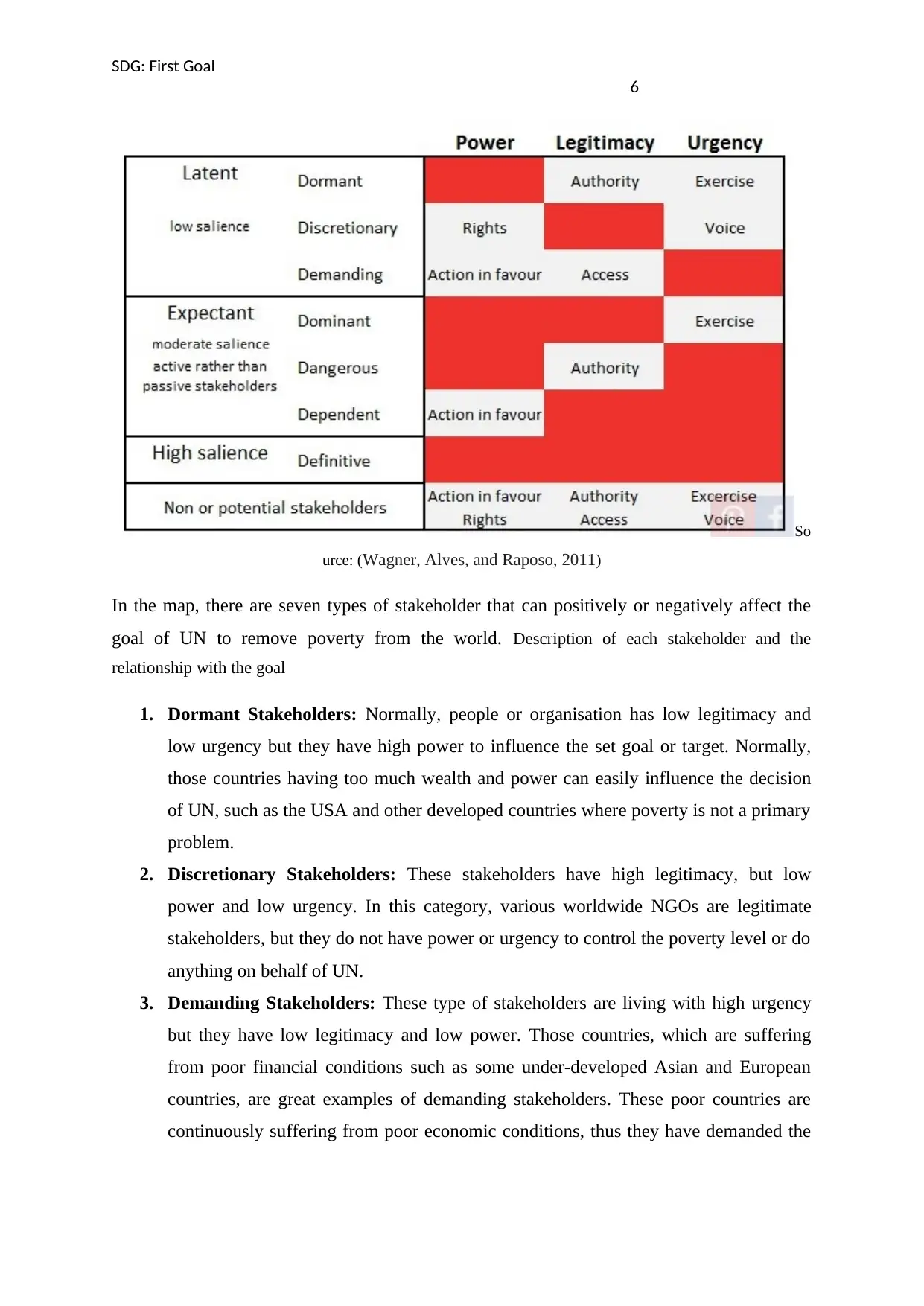
SDG: First Goal
6
So
urce: (Wagner, Alves, and Raposo, 2011)
In the map, there are seven types of stakeholder that can positively or negatively affect the
goal of UN to remove poverty from the world. Description of each stakeholder and the
relationship with the goal
1. Dormant Stakeholders: Normally, people or organisation has low legitimacy and
low urgency but they have high power to influence the set goal or target. Normally,
those countries having too much wealth and power can easily influence the decision
of UN, such as the USA and other developed countries where poverty is not a primary
problem.
2. Discretionary Stakeholders: These stakeholders have high legitimacy, but low
power and low urgency. In this category, various worldwide NGOs are legitimate
stakeholders, but they do not have power or urgency to control the poverty level or do
anything on behalf of UN.
3. Demanding Stakeholders: These type of stakeholders are living with high urgency
but they have low legitimacy and low power. Those countries, which are suffering
from poor financial conditions such as some under-developed Asian and European
countries, are great examples of demanding stakeholders. These poor countries are
continuously suffering from poor economic conditions, thus they have demanded the
6
So
urce: (Wagner, Alves, and Raposo, 2011)
In the map, there are seven types of stakeholder that can positively or negatively affect the
goal of UN to remove poverty from the world. Description of each stakeholder and the
relationship with the goal
1. Dormant Stakeholders: Normally, people or organisation has low legitimacy and
low urgency but they have high power to influence the set goal or target. Normally,
those countries having too much wealth and power can easily influence the decision
of UN, such as the USA and other developed countries where poverty is not a primary
problem.
2. Discretionary Stakeholders: These stakeholders have high legitimacy, but low
power and low urgency. In this category, various worldwide NGOs are legitimate
stakeholders, but they do not have power or urgency to control the poverty level or do
anything on behalf of UN.
3. Demanding Stakeholders: These type of stakeholders are living with high urgency
but they have low legitimacy and low power. Those countries, which are suffering
from poor financial conditions such as some under-developed Asian and European
countries, are great examples of demanding stakeholders. These poor countries are
continuously suffering from poor economic conditions, thus they have demanded the
Paraphrase This Document
Need a fresh take? Get an instant paraphrase of this document with our AI Paraphraser
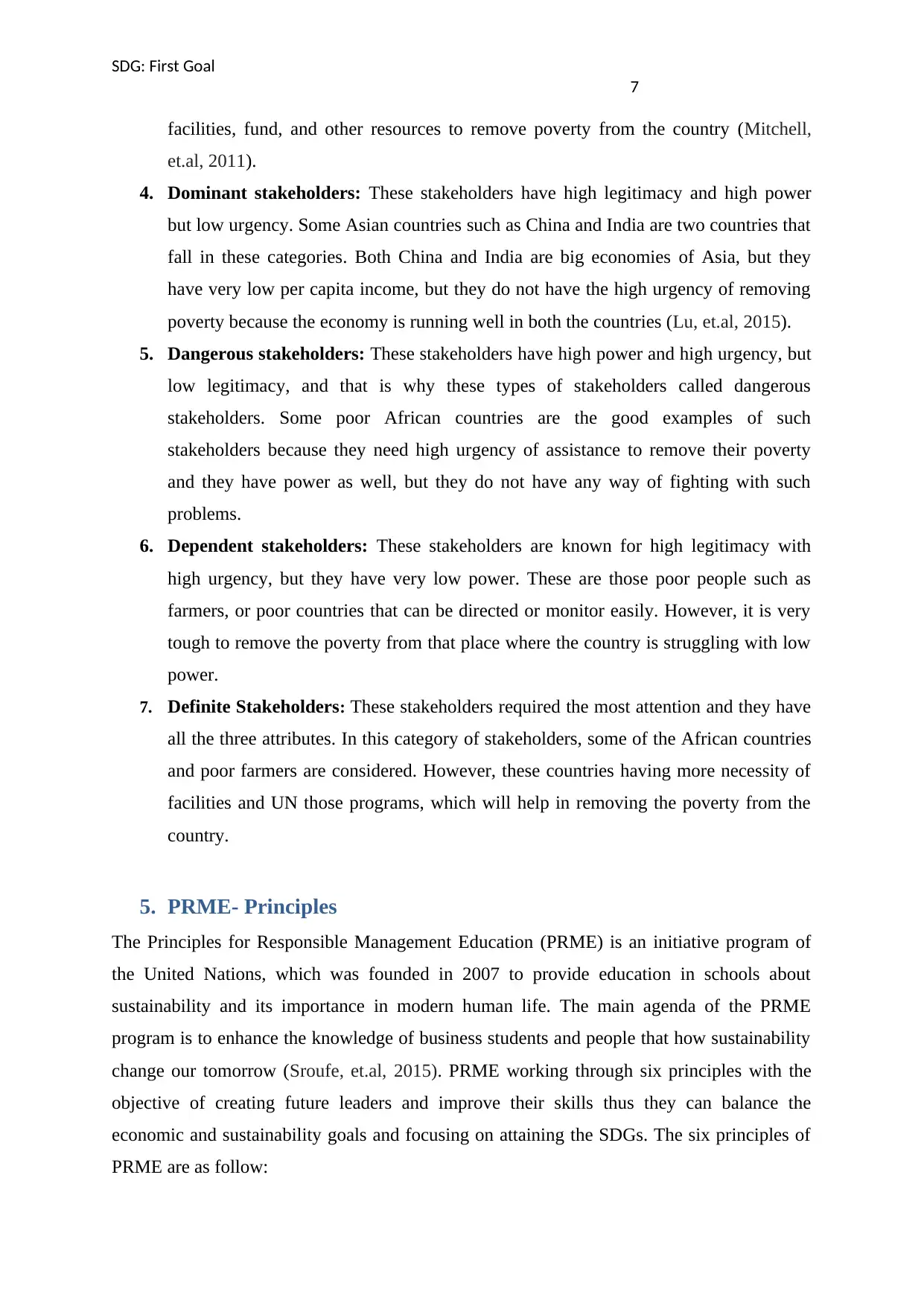
SDG: First Goal
7
facilities, fund, and other resources to remove poverty from the country (Mitchell,
et.al, 2011).
4. Dominant stakeholders: These stakeholders have high legitimacy and high power
but low urgency. Some Asian countries such as China and India are two countries that
fall in these categories. Both China and India are big economies of Asia, but they
have very low per capita income, but they do not have the high urgency of removing
poverty because the economy is running well in both the countries (Lu, et.al, 2015).
5. Dangerous stakeholders: These stakeholders have high power and high urgency, but
low legitimacy, and that is why these types of stakeholders called dangerous
stakeholders. Some poor African countries are the good examples of such
stakeholders because they need high urgency of assistance to remove their poverty
and they have power as well, but they do not have any way of fighting with such
problems.
6. Dependent stakeholders: These stakeholders are known for high legitimacy with
high urgency, but they have very low power. These are those poor people such as
farmers, or poor countries that can be directed or monitor easily. However, it is very
tough to remove the poverty from that place where the country is struggling with low
power.
7. Definite Stakeholders: These stakeholders required the most attention and they have
all the three attributes. In this category of stakeholders, some of the African countries
and poor farmers are considered. However, these countries having more necessity of
facilities and UN those programs, which will help in removing the poverty from the
country.
5. PRME- Principles
The Principles for Responsible Management Education (PRME) is an initiative program of
the United Nations, which was founded in 2007 to provide education in schools about
sustainability and its importance in modern human life. The main agenda of the PRME
program is to enhance the knowledge of business students and people that how sustainability
change our tomorrow (Sroufe, et.al, 2015). PRME working through six principles with the
objective of creating future leaders and improve their skills thus they can balance the
economic and sustainability goals and focusing on attaining the SDGs. The six principles of
PRME are as follow:
7
facilities, fund, and other resources to remove poverty from the country (Mitchell,
et.al, 2011).
4. Dominant stakeholders: These stakeholders have high legitimacy and high power
but low urgency. Some Asian countries such as China and India are two countries that
fall in these categories. Both China and India are big economies of Asia, but they
have very low per capita income, but they do not have the high urgency of removing
poverty because the economy is running well in both the countries (Lu, et.al, 2015).
5. Dangerous stakeholders: These stakeholders have high power and high urgency, but
low legitimacy, and that is why these types of stakeholders called dangerous
stakeholders. Some poor African countries are the good examples of such
stakeholders because they need high urgency of assistance to remove their poverty
and they have power as well, but they do not have any way of fighting with such
problems.
6. Dependent stakeholders: These stakeholders are known for high legitimacy with
high urgency, but they have very low power. These are those poor people such as
farmers, or poor countries that can be directed or monitor easily. However, it is very
tough to remove the poverty from that place where the country is struggling with low
power.
7. Definite Stakeholders: These stakeholders required the most attention and they have
all the three attributes. In this category of stakeholders, some of the African countries
and poor farmers are considered. However, these countries having more necessity of
facilities and UN those programs, which will help in removing the poverty from the
country.
5. PRME- Principles
The Principles for Responsible Management Education (PRME) is an initiative program of
the United Nations, which was founded in 2007 to provide education in schools about
sustainability and its importance in modern human life. The main agenda of the PRME
program is to enhance the knowledge of business students and people that how sustainability
change our tomorrow (Sroufe, et.al, 2015). PRME working through six principles with the
objective of creating future leaders and improve their skills thus they can balance the
economic and sustainability goals and focusing on attaining the SDGs. The six principles of
PRME are as follow:
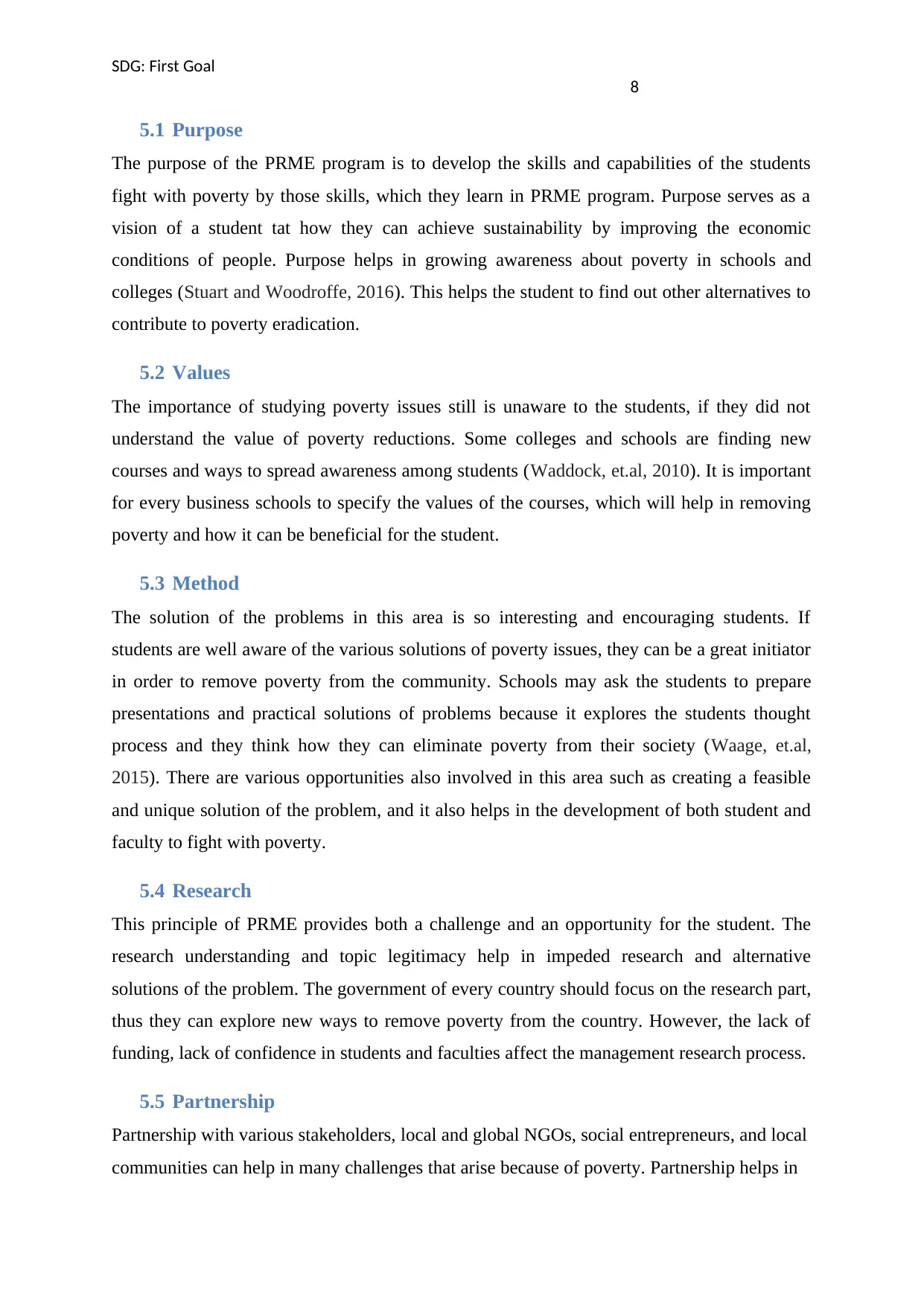
SDG: First Goal
8
5.1 Purpose
The purpose of the PRME program is to develop the skills and capabilities of the students
fight with poverty by those skills, which they learn in PRME program. Purpose serves as a
vision of a student tat how they can achieve sustainability by improving the economic
conditions of people. Purpose helps in growing awareness about poverty in schools and
colleges (Stuart and Woodroffe, 2016). This helps the student to find out other alternatives to
contribute to poverty eradication.
5.2 Values
The importance of studying poverty issues still is unaware to the students, if they did not
understand the value of poverty reductions. Some colleges and schools are finding new
courses and ways to spread awareness among students (Waddock, et.al, 2010). It is important
for every business schools to specify the values of the courses, which will help in removing
poverty and how it can be beneficial for the student.
5.3 Method
The solution of the problems in this area is so interesting and encouraging students. If
students are well aware of the various solutions of poverty issues, they can be a great initiator
in order to remove poverty from the community. Schools may ask the students to prepare
presentations and practical solutions of problems because it explores the students thought
process and they think how they can eliminate poverty from their society (Waage, et.al,
2015). There are various opportunities also involved in this area such as creating a feasible
and unique solution of the problem, and it also helps in the development of both student and
faculty to fight with poverty.
5.4 Research
This principle of PRME provides both a challenge and an opportunity for the student. The
research understanding and topic legitimacy help in impeded research and alternative
solutions of the problem. The government of every country should focus on the research part,
thus they can explore new ways to remove poverty from the country. However, the lack of
funding, lack of confidence in students and faculties affect the management research process.
5.5 Partnership
Partnership with various stakeholders, local and global NGOs, social entrepreneurs, and local
communities can help in many challenges that arise because of poverty. Partnership helps in
8
5.1 Purpose
The purpose of the PRME program is to develop the skills and capabilities of the students
fight with poverty by those skills, which they learn in PRME program. Purpose serves as a
vision of a student tat how they can achieve sustainability by improving the economic
conditions of people. Purpose helps in growing awareness about poverty in schools and
colleges (Stuart and Woodroffe, 2016). This helps the student to find out other alternatives to
contribute to poverty eradication.
5.2 Values
The importance of studying poverty issues still is unaware to the students, if they did not
understand the value of poverty reductions. Some colleges and schools are finding new
courses and ways to spread awareness among students (Waddock, et.al, 2010). It is important
for every business schools to specify the values of the courses, which will help in removing
poverty and how it can be beneficial for the student.
5.3 Method
The solution of the problems in this area is so interesting and encouraging students. If
students are well aware of the various solutions of poverty issues, they can be a great initiator
in order to remove poverty from the community. Schools may ask the students to prepare
presentations and practical solutions of problems because it explores the students thought
process and they think how they can eliminate poverty from their society (Waage, et.al,
2015). There are various opportunities also involved in this area such as creating a feasible
and unique solution of the problem, and it also helps in the development of both student and
faculty to fight with poverty.
5.4 Research
This principle of PRME provides both a challenge and an opportunity for the student. The
research understanding and topic legitimacy help in impeded research and alternative
solutions of the problem. The government of every country should focus on the research part,
thus they can explore new ways to remove poverty from the country. However, the lack of
funding, lack of confidence in students and faculties affect the management research process.
5.5 Partnership
Partnership with various stakeholders, local and global NGOs, social entrepreneurs, and local
communities can help in many challenges that arise because of poverty. Partnership helps in
⊘ This is a preview!⊘
Do you want full access?
Subscribe today to unlock all pages.

Trusted by 1+ million students worldwide
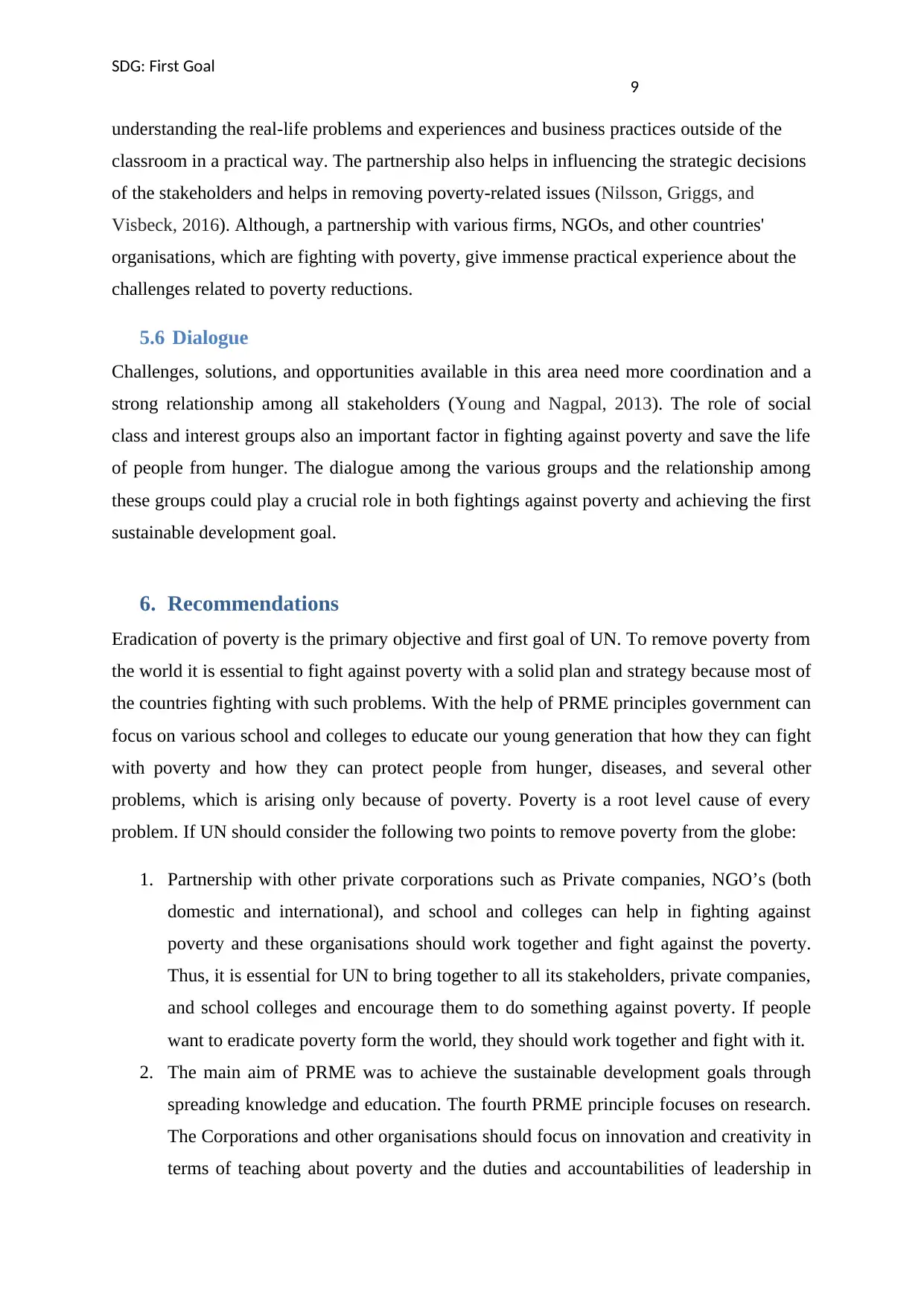
SDG: First Goal
9
understanding the real-life problems and experiences and business practices outside of the
classroom in a practical way. The partnership also helps in influencing the strategic decisions
of the stakeholders and helps in removing poverty-related issues (Nilsson, Griggs, and
Visbeck, 2016). Although, a partnership with various firms, NGOs, and other countries'
organisations, which are fighting with poverty, give immense practical experience about the
challenges related to poverty reductions.
5.6 Dialogue
Challenges, solutions, and opportunities available in this area need more coordination and a
strong relationship among all stakeholders (Young and Nagpal, 2013). The role of social
class and interest groups also an important factor in fighting against poverty and save the life
of people from hunger. The dialogue among the various groups and the relationship among
these groups could play a crucial role in both fightings against poverty and achieving the first
sustainable development goal.
6. Recommendations
Eradication of poverty is the primary objective and first goal of UN. To remove poverty from
the world it is essential to fight against poverty with a solid plan and strategy because most of
the countries fighting with such problems. With the help of PRME principles government can
focus on various school and colleges to educate our young generation that how they can fight
with poverty and how they can protect people from hunger, diseases, and several other
problems, which is arising only because of poverty. Poverty is a root level cause of every
problem. If UN should consider the following two points to remove poverty from the globe:
1. Partnership with other private corporations such as Private companies, NGO’s (both
domestic and international), and school and colleges can help in fighting against
poverty and these organisations should work together and fight against the poverty.
Thus, it is essential for UN to bring together to all its stakeholders, private companies,
and school colleges and encourage them to do something against poverty. If people
want to eradicate poverty form the world, they should work together and fight with it.
2. The main aim of PRME was to achieve the sustainable development goals through
spreading knowledge and education. The fourth PRME principle focuses on research.
The Corporations and other organisations should focus on innovation and creativity in
terms of teaching about poverty and the duties and accountabilities of leadership in
9
understanding the real-life problems and experiences and business practices outside of the
classroom in a practical way. The partnership also helps in influencing the strategic decisions
of the stakeholders and helps in removing poverty-related issues (Nilsson, Griggs, and
Visbeck, 2016). Although, a partnership with various firms, NGOs, and other countries'
organisations, which are fighting with poverty, give immense practical experience about the
challenges related to poverty reductions.
5.6 Dialogue
Challenges, solutions, and opportunities available in this area need more coordination and a
strong relationship among all stakeholders (Young and Nagpal, 2013). The role of social
class and interest groups also an important factor in fighting against poverty and save the life
of people from hunger. The dialogue among the various groups and the relationship among
these groups could play a crucial role in both fightings against poverty and achieving the first
sustainable development goal.
6. Recommendations
Eradication of poverty is the primary objective and first goal of UN. To remove poverty from
the world it is essential to fight against poverty with a solid plan and strategy because most of
the countries fighting with such problems. With the help of PRME principles government can
focus on various school and colleges to educate our young generation that how they can fight
with poverty and how they can protect people from hunger, diseases, and several other
problems, which is arising only because of poverty. Poverty is a root level cause of every
problem. If UN should consider the following two points to remove poverty from the globe:
1. Partnership with other private corporations such as Private companies, NGO’s (both
domestic and international), and school and colleges can help in fighting against
poverty and these organisations should work together and fight against the poverty.
Thus, it is essential for UN to bring together to all its stakeholders, private companies,
and school colleges and encourage them to do something against poverty. If people
want to eradicate poverty form the world, they should work together and fight with it.
2. The main aim of PRME was to achieve the sustainable development goals through
spreading knowledge and education. The fourth PRME principle focuses on research.
The Corporations and other organisations should focus on innovation and creativity in
terms of teaching about poverty and the duties and accountabilities of leadership in
Paraphrase This Document
Need a fresh take? Get an instant paraphrase of this document with our AI Paraphraser
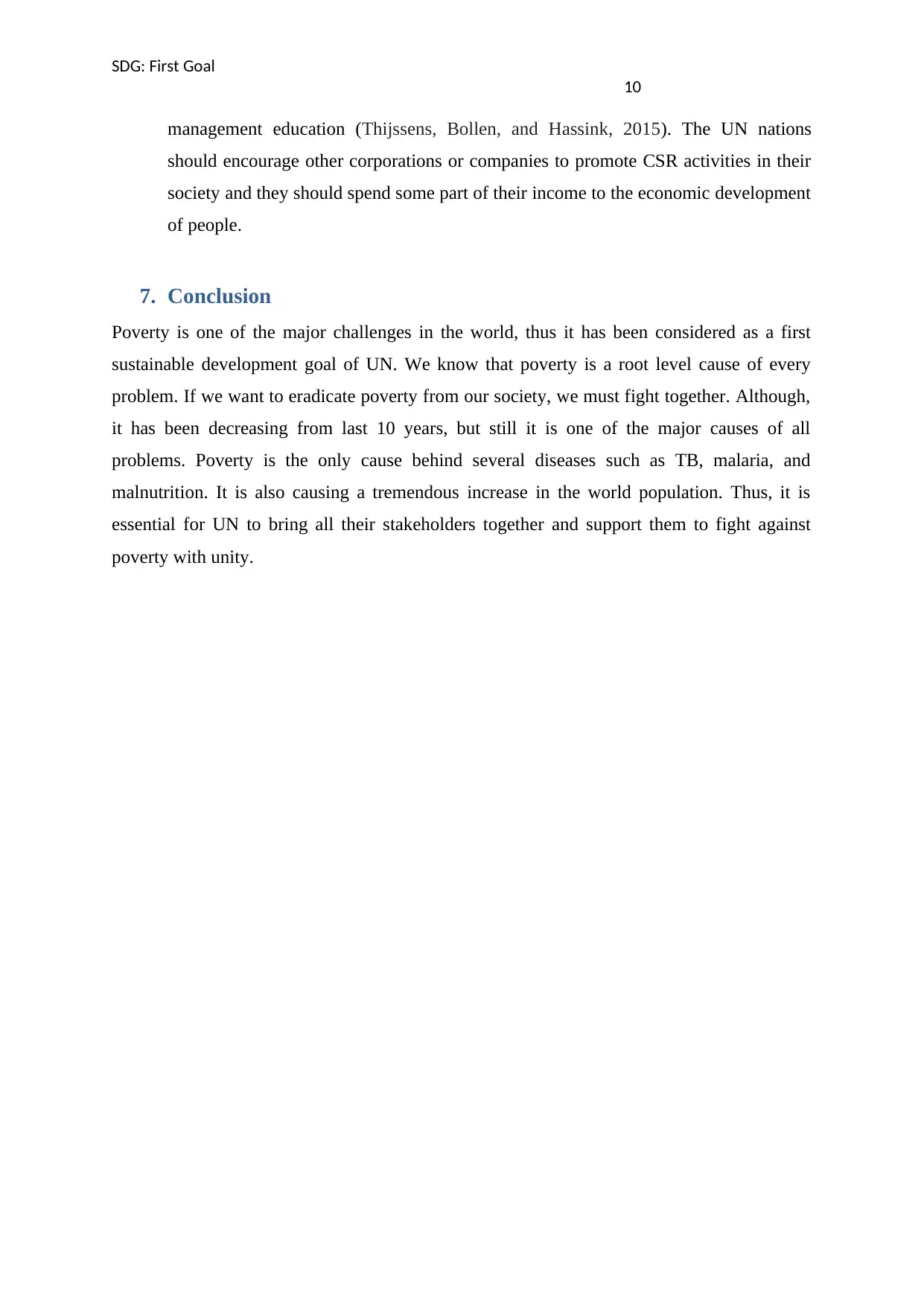
SDG: First Goal
10
management education (Thijssens, Bollen, and Hassink, 2015). The UN nations
should encourage other corporations or companies to promote CSR activities in their
society and they should spend some part of their income to the economic development
of people.
7. Conclusion
Poverty is one of the major challenges in the world, thus it has been considered as a first
sustainable development goal of UN. We know that poverty is a root level cause of every
problem. If we want to eradicate poverty from our society, we must fight together. Although,
it has been decreasing from last 10 years, but still it is one of the major causes of all
problems. Poverty is the only cause behind several diseases such as TB, malaria, and
malnutrition. It is also causing a tremendous increase in the world population. Thus, it is
essential for UN to bring all their stakeholders together and support them to fight against
poverty with unity.
10
management education (Thijssens, Bollen, and Hassink, 2015). The UN nations
should encourage other corporations or companies to promote CSR activities in their
society and they should spend some part of their income to the economic development
of people.
7. Conclusion
Poverty is one of the major challenges in the world, thus it has been considered as a first
sustainable development goal of UN. We know that poverty is a root level cause of every
problem. If we want to eradicate poverty from our society, we must fight together. Although,
it has been decreasing from last 10 years, but still it is one of the major causes of all
problems. Poverty is the only cause behind several diseases such as TB, malaria, and
malnutrition. It is also causing a tremendous increase in the world population. Thus, it is
essential for UN to bring all their stakeholders together and support them to fight against
poverty with unity.
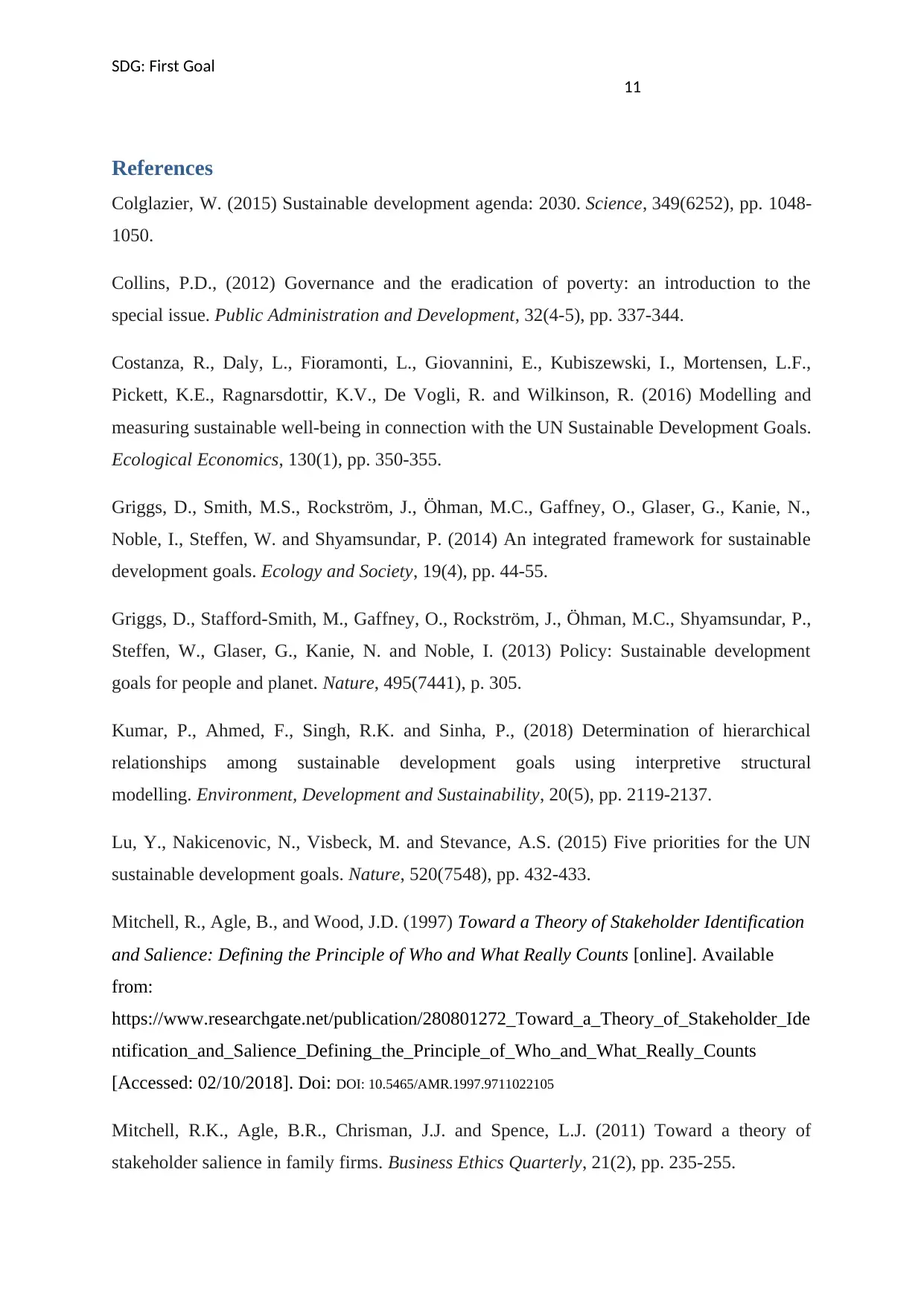
SDG: First Goal
11
References
Colglazier, W. (2015) Sustainable development agenda: 2030. Science, 349(6252), pp. 1048-
1050.
Collins, P.D., (2012) Governance and the eradication of poverty: an introduction to the
special issue. Public Administration and Development, 32(4-5), pp. 337-344.
Costanza, R., Daly, L., Fioramonti, L., Giovannini, E., Kubiszewski, I., Mortensen, L.F.,
Pickett, K.E., Ragnarsdottir, K.V., De Vogli, R. and Wilkinson, R. (2016) Modelling and
measuring sustainable well-being in connection with the UN Sustainable Development Goals.
Ecological Economics, 130(1), pp. 350-355.
Griggs, D., Smith, M.S., Rockström, J., Öhman, M.C., Gaffney, O., Glaser, G., Kanie, N.,
Noble, I., Steffen, W. and Shyamsundar, P. (2014) An integrated framework for sustainable
development goals. Ecology and Society, 19(4), pp. 44-55.
Griggs, D., Stafford-Smith, M., Gaffney, O., Rockström, J., Öhman, M.C., Shyamsundar, P.,
Steffen, W., Glaser, G., Kanie, N. and Noble, I. (2013) Policy: Sustainable development
goals for people and planet. Nature, 495(7441), p. 305.
Kumar, P., Ahmed, F., Singh, R.K. and Sinha, P., (2018) Determination of hierarchical
relationships among sustainable development goals using interpretive structural
modelling. Environment, Development and Sustainability, 20(5), pp. 2119-2137.
Lu, Y., Nakicenovic, N., Visbeck, M. and Stevance, A.S. (2015) Five priorities for the UN
sustainable development goals. Nature, 520(7548), pp. 432-433.
Mitchell, R., Agle, B., and Wood, J.D. (1997) Toward a Theory of Stakeholder Identification
and Salience: Defining the Principle of Who and What Really Counts [online]. Available
from:
https://www.researchgate.net/publication/280801272_Toward_a_Theory_of_Stakeholder_Ide
ntification_and_Salience_Defining_the_Principle_of_Who_and_What_Really_Counts
[Accessed: 02/10/2018]. Doi: DOI: 10.5465/AMR.1997.9711022105
Mitchell, R.K., Agle, B.R., Chrisman, J.J. and Spence, L.J. (2011) Toward a theory of
stakeholder salience in family firms. Business Ethics Quarterly, 21(2), pp. 235-255.
11
References
Colglazier, W. (2015) Sustainable development agenda: 2030. Science, 349(6252), pp. 1048-
1050.
Collins, P.D., (2012) Governance and the eradication of poverty: an introduction to the
special issue. Public Administration and Development, 32(4-5), pp. 337-344.
Costanza, R., Daly, L., Fioramonti, L., Giovannini, E., Kubiszewski, I., Mortensen, L.F.,
Pickett, K.E., Ragnarsdottir, K.V., De Vogli, R. and Wilkinson, R. (2016) Modelling and
measuring sustainable well-being in connection with the UN Sustainable Development Goals.
Ecological Economics, 130(1), pp. 350-355.
Griggs, D., Smith, M.S., Rockström, J., Öhman, M.C., Gaffney, O., Glaser, G., Kanie, N.,
Noble, I., Steffen, W. and Shyamsundar, P. (2014) An integrated framework for sustainable
development goals. Ecology and Society, 19(4), pp. 44-55.
Griggs, D., Stafford-Smith, M., Gaffney, O., Rockström, J., Öhman, M.C., Shyamsundar, P.,
Steffen, W., Glaser, G., Kanie, N. and Noble, I. (2013) Policy: Sustainable development
goals for people and planet. Nature, 495(7441), p. 305.
Kumar, P., Ahmed, F., Singh, R.K. and Sinha, P., (2018) Determination of hierarchical
relationships among sustainable development goals using interpretive structural
modelling. Environment, Development and Sustainability, 20(5), pp. 2119-2137.
Lu, Y., Nakicenovic, N., Visbeck, M. and Stevance, A.S. (2015) Five priorities for the UN
sustainable development goals. Nature, 520(7548), pp. 432-433.
Mitchell, R., Agle, B., and Wood, J.D. (1997) Toward a Theory of Stakeholder Identification
and Salience: Defining the Principle of Who and What Really Counts [online]. Available
from:
https://www.researchgate.net/publication/280801272_Toward_a_Theory_of_Stakeholder_Ide
ntification_and_Salience_Defining_the_Principle_of_Who_and_What_Really_Counts
[Accessed: 02/10/2018]. Doi: DOI: 10.5465/AMR.1997.9711022105
Mitchell, R.K., Agle, B.R., Chrisman, J.J. and Spence, L.J. (2011) Toward a theory of
stakeholder salience in family firms. Business Ethics Quarterly, 21(2), pp. 235-255.
⊘ This is a preview!⊘
Do you want full access?
Subscribe today to unlock all pages.

Trusted by 1+ million students worldwide
1 out of 14
Related Documents
Your All-in-One AI-Powered Toolkit for Academic Success.
+13062052269
info@desklib.com
Available 24*7 on WhatsApp / Email
![[object Object]](/_next/static/media/star-bottom.7253800d.svg)
Unlock your academic potential
Copyright © 2020–2025 A2Z Services. All Rights Reserved. Developed and managed by ZUCOL.




